Week 01
From Data to Insight: The Importance of Clean Data
DS105A – Data for Data Science
🗓️ 13 Dec 2025
Today’s Goals:
- Intro: Meet the team
- Logistics: Understand what this course is about
- Intros: Tell us about yourselves
- Discuss: the 📝 W01 Practice Exercise
- New Content: about the data science workflow we will adopt in this course
Meet the DS105A Team!

Course Lead

Dr Jon Cardoso-Silva 📧 @jonjoncardoso
Assistant Professor (Education)
LSE Data Science Institute
Course Leader
Expertise & Current Projects
- PhD in Computer Science
- Experienced in software engineering, data science and data engineering
- Investigating the impact of GenAI impact on higher education (
![]() GENIAL project*)
GENIAL project*)
🏆 Winner of LSESU Teaching Award for Feedback & Communication (2023)
Office Hours:
(Typically) Wednesdays 14:00-16:00
Book via StudentHub
* Read more about the ![]() GENIAL project here.
GENIAL project here.
Teaching Support



Riya Chhikara
Tabtim Duenger
Pedro Henrique
Class Teacher
Class Teacher
Class Teacher
Teaches: CG3 & CG4
Teaches: CG1, CG2 & CG8
Teaches: CG5, CG6 & CG7
Role outside DSI:
Data Scientist at
The Economist
Role outside DSI:
Data Scientist at
The Economist
Role outside DSI:
PhD Candidate in Computer Science at King’s College London
Administrative Support

Kevin Kittoe
Teaching & Assessment Administrator (DSI)
Admin
Contact 📧 DSI.ug@lse.ac.uk for:
- Course access issues
- Assignment submissions
- Extension requests
- Administrative queries
Key Information:
- All extension requests must follow LSE’s extension policy
- Email response time: 24-48 hours
- Include ‘[DS105A]’ in email subject lines
Where will you be at the end of this course?
- The value of student autonomy in this course
- Example of group projects from previous years.
Bird Migration Project
Project from the 🌐 ‘Natural Stupidity’ group submitted in the 2024/25 Winter Term iteration of DS105.
Using data from 🐦 eBird amongst other sources, the group traced the prevalence of species migrating through the UK.
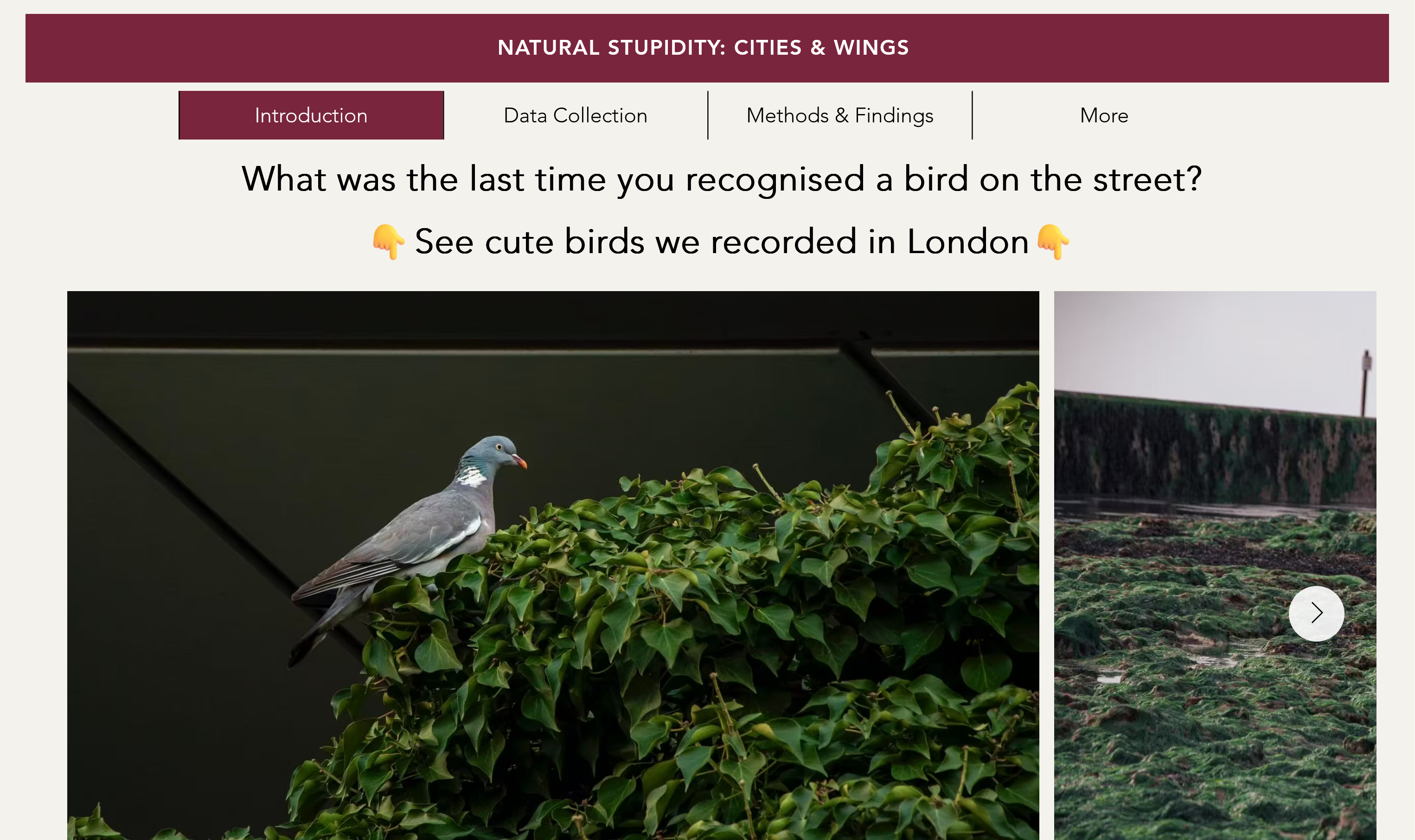
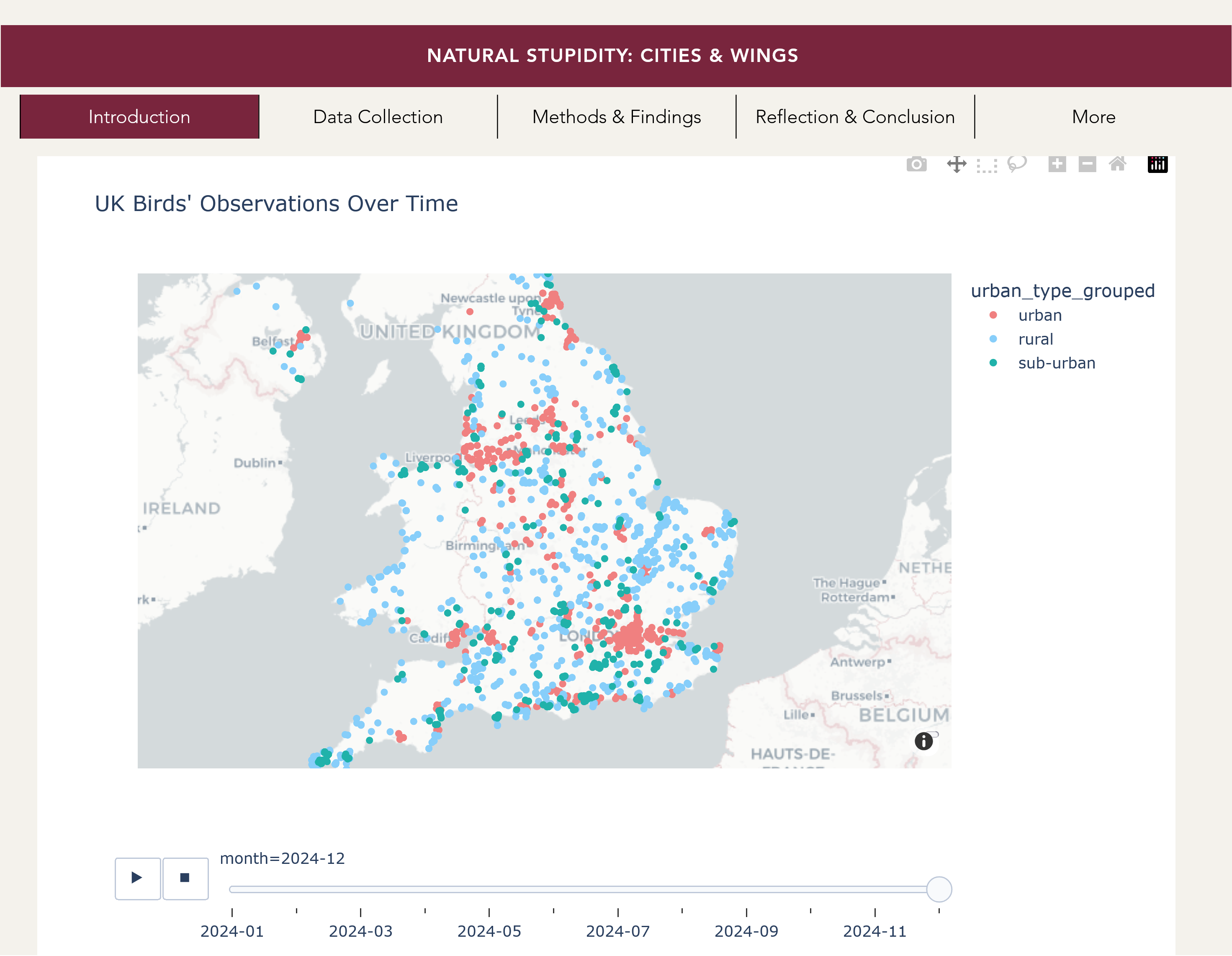
Pokemon Project
This team decided to answer this silly question: “If Pokemon were real, where would they live on Earth?”
See 🌐 their final website for more details.
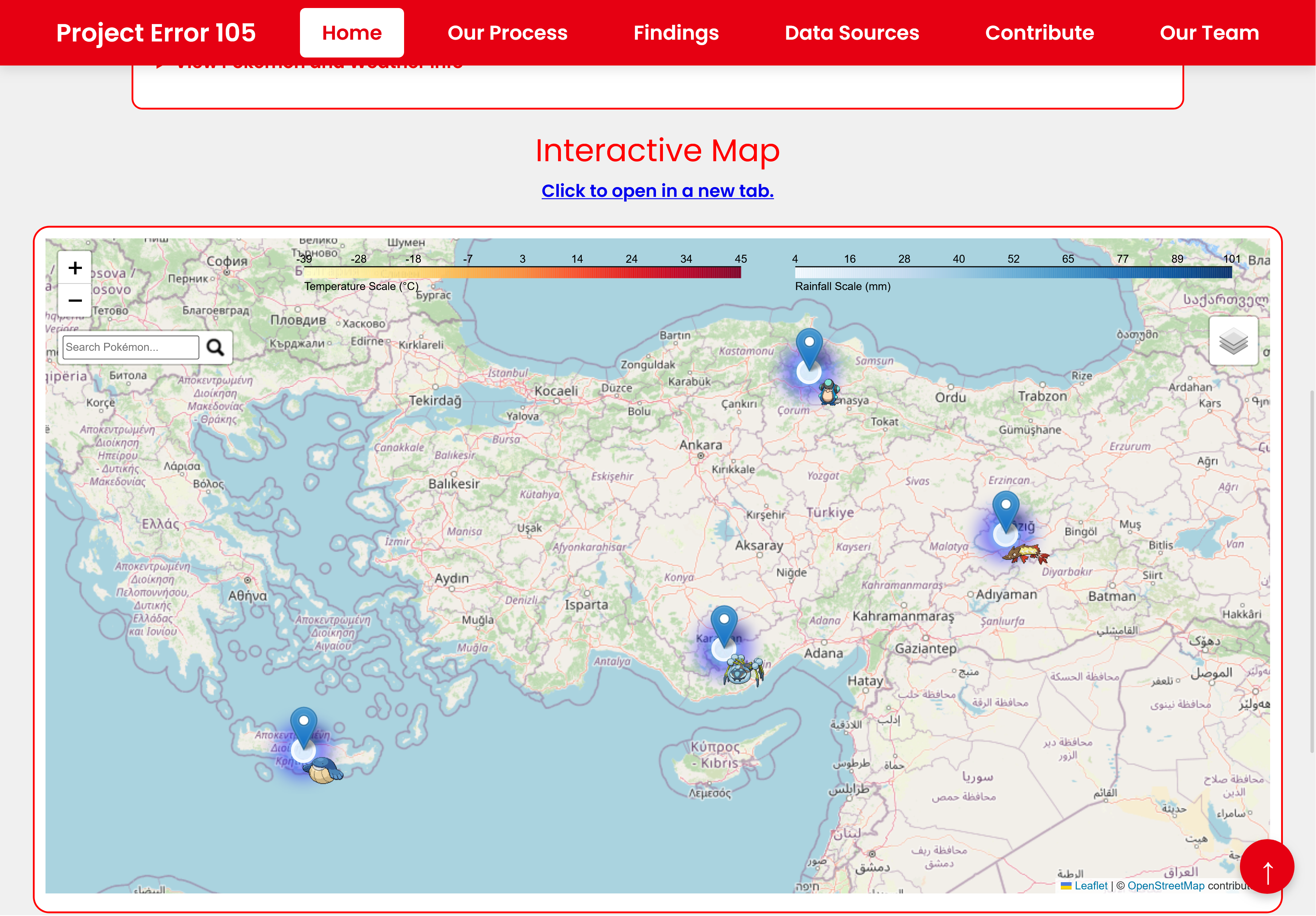
How will you get there?
The DS105 way is to practise every week until you master the data science workflow below.
I will come back to this diagramlater.
DS105 ethos
- You learn more if you are given some autonomy. In the first assignments, you have a strict set of instructions but as we progress, you will be given increasingly more freedom to choose the kind of project you want to work on.
DS105 ethos
You learn more if you are given some autonomy. In the first assignments, you have a strict set of instructions but as we progress, you will be given increasingly more freedom to choose the kind of project you want to work on.
We adopt a learn by doing approach. We want you to be spending more time practising (doing stuff) rather than reading about programming and data science.
DS105 ethos
You learn more if you are given some autonomy. In the first assignments, you have a strict set of instructions but as we progress, you will be given increasingly more freedom to choose the kind of project you want to work on.
We adopt a learn by doing approach. We want you to be spending more time practising (doing stuff) rather than reading about programming and data science.
We value good communication and collaboration. We like it when you feel comfortable to ask questions in front of the class or on the public channels Slack, and to see you working together in person or in our digital spaces!
✍️ Assessment Structure
We designed the assignments to be in line with the principles mentioned in the previous slides.
Here’s how you will be assessed ⏭️
Individual Work- 60% of final grade
📝
Practice Exercises (not graded*)
During Weeks 1-4, we (mostly) tell you what to do.
* Except for General Course and exchange students.
✍️
Mini Project I (20%)
You will be given a data source and a question we want you to answer from it. How you answer it is up to you (within constraints).
Released W04 | Due W06
✍️
Mini Project II (30%)
You will be given a data source but it is up to you to decide what question to answer from it.
Released W07 | Due W10
👤
Individual Contribution (10%)
Show us that you have made a meaningful contribution to the group project.
(see next slide)
Group Work - 40% of final grade
The moment of maximum freedom in this course is when you are working in a group.
For your 👥 Group Project, you choose which data source to use and what question to answer from it.
🗣️
Pitch Presentation (10%)
Convince us that you have an interesting idea for a project and good execution plan for the next couple of months.
Instructions released W10 |
Presentations Friday of W11
📦
Final Project (30%)
Document your group’s thinking, communicate findings to a technical as well as a wider audience.
Instructions released W11 |
Due early Feb 2026
What do the assignments measure?
| Outcome Category | What You’ll Master |
|---|---|
| Data Fundamentals & Python Mastery | • Master data types, structures, and common formats (CSV, JSON, API responses) • Apply Python and pandas to clean, reshape and transform raw data • Identify and resolve common data quality issues |
| Analytical Workflows | • Design and implement complete data analysis workflows • Integrate data from multiple sources effectively • Apply the data science pipeline from collection to communication |
| Database & SQL Skills | • Understand database normalisation concepts • Execute SQL queries for data retrieval and analysis • Design schemas for multi-table data relationships |
| Visualisation & Critical Analysis | • Create visualisations using seaborn with grammar-of-graphics principles • Critically evaluate visualisations and avoid misleading representations • Distinguish between correlation and causation in data patterns |
| Collaborative Development | • Use Git and GitHub for version control and collaborative workflows • Organise team-based data science projects • Review and merge code systematically |
| Professional Communication | • Understand markup languages fundamentals (HTML, Markdown) • Create and maintain simple websites using HTML and CSS • Craft clear, accurate and responsible data reports |
📑 Key Information
📟 Communication & Support
Slack is our main point of contact. The invitation link will be available on Moodle.
- 📧 Email: Reserved for formal requests (extensions, appeals)
- 📅 Office Hours: Book via StudentHub
- 🆘 Drop-in Support: COL.1.06 (DSI Studio) - Check current schedule
No Software Installation Required
All coding happens in the browser via ![]() Nuvolos Cloud with VS Code and Jupyter pre-configured.
Nuvolos Cloud with VS Code and Jupyter pre-configured.
Visit Nuvolos - First Time Access to get started.
Weekly schedule, assessment deadlines, and complete learning progression.
Let’s Meet You!
Join me on a Mentimeter activity to get to know you better.
🧘 Quick Break
Let’s take 10 minutes to stretch our legs, drink some water and come back refreshed.
When we return:
- What is the data science workflow?
- How should you think when doing an analysis?
- Generative AI: help or hindrance?

The Data Science Workflow
Illustration of the typical steps involved
What raw data looks like
Once you start collecting data (very soon in this course), you will get data that might look like this:
{“latitude”:52.54833,“longitude”:13.407822,“generationtime_ms”:0.5619525909423828,“utc_offset_seconds”:0,“timezone”:“GMT”,“timezone_abbreviation”:“GMT”,“elevation”:38.0,“hourly_units”:{“time”:“iso8601”,“temperature_2m”:“°C”,“weather_code”:“wmo code”,“precipitation”:“mm”,“wet_bulb_temperature_2m”:“°C”},“hourly”:{“time”:[“2025-09-17T00:00”,“2025-09-17T01:00”,“2025-09-17T02:00”,“2025-09-17T03:00”,“2025-09-17T04:00”,“2025-09-17T05:00”,“2025-09-17T06:00”,“2025-09-17T07:00”,“2025-09-17T08:00”,“2025-09-17T09:00”,“2025-09-17T10:00”,“2025-09-17T11:00”,“2025-09-17T12:00”,“2025-09-17T13:00”,“2025-09-17T14:00”,“2025-09-17T15:00”,“2025-09-17T16:00”,“2025-09-17T17:00”,“2025-09-17T18:00”,“2025-09-17T19:00”,“2025-09-17T20:00”,“2025-09-17T21:00”,“2025-09-17T22:00”,“2025-09-17T23:00”,“2025-09-18T00:00”,“2025-09-18T01:00”,“2025-09-18T02:00”,“2025-09-18T03:00”,“2025-09-18T04:00”,“2025-09-18T05:00”,“2025-09-18T06:00”,“2025-09-18T07:00”,“2025-09-18T08:00”,“2025-09-18T09:00”,“2025-09-18T10:00”,“2025-09-18T11:00”,“2025-09-18T12:00”,“2025-09-18T13:00”,“2025-09-18T14:00”,“2025-09-18T15:00”,“2025-09-18T16:00”,“2025-09-18T17:00”,“2025-09-18T18:00”,“2025-09-18T19:00”,“2025-09-18T20:00”,“2025-09-18T21:00”,“2025-09-18T22:00”,“2025-09-18T23:00”],“temperature_2m”:[12.3,12.5,12.4,12.2,11.7,11.4,12.2,13.1,14.1,15.1,16.2,17.1,17.9,17.4,17.7,17.5,16.7,15.7,14.7,13.9,13.5,13.2,13.1,13.6,14.2,14.5,14.4,14.6,14.7,14.7,14.8,15.6,16.6,17.9,18.9,18.8,19.3,19.4,19.2,19.4,19.3,19.2,19.1,18.8,18.6,18.7,18.8,18.5],“weather_code”:[1,51,2,1,1,2,3,3,3,51,3,1,1,2,1,51,2,0,0,1,1,3,3,3,3,3,3,3,3,51,51,3,3,3,3,3,3,51,3,3,3,3,2,3,3,3,3,3],“precipitation”:[0.00,0.10,0.00,0.00,0.00,0.00,0.00,0.00,0.00,0.10,0.00,0.00,0.00,0.00,0.00,0.10,0.00,0.00,0.00,0.00,0.00,0.00,0.00,0.00,0.00,0.00,0.00,0.00,0.00,0.30,0.10,0.00,0.00,0.00,0.00,0.00,0.00,0.10,0.00,0.00,0.00,0.00,0.00,0.00,0.00,0.00,0.00,0.00],“wet_bulb_temperature_2m”:[10.8,11.6,11.6,11.3,10.9,10.7,11.1,11.5,11.8,12.4,12.9,12.9,12.9,12.6,12.6,12.6,12.6,12.2,11.7,11.5,11.1,10.9,10.7,11.1,11.5,12.1,12.2,12.5,12.8,13.1,13.4,14.0,14.8,15.6,16.1,16.1,16.5,16.9,16.9,16.9,16.9,16.7,16.8,16.6,16.6,16.7,16.6,16.4]}}
What raw data looks like
You will then learn that you have to impose a structure on this data to make working with it more manageable.
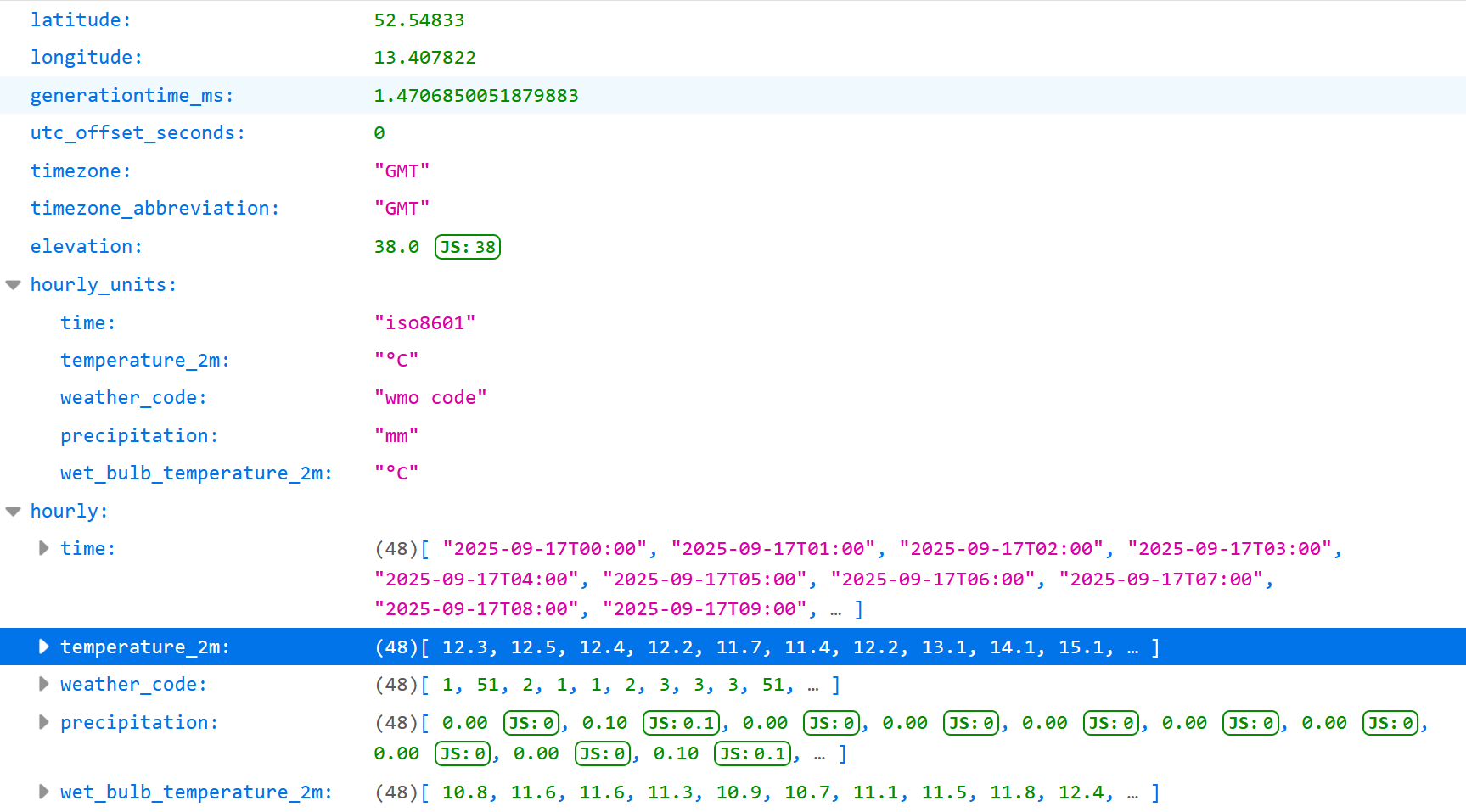
What ‘tidy data’ looks like
You will then discover that tables are often the best format to store data.
| time | temperature_2m | weather_code | precipitation | wet_bulb_temperature_2m | |
|---|---|---|---|---|---|
| 0 | 2025-09-16T00:00 | 15.7 | 0 | 0 | 12.1 |
| 1 | 2025-09-16T01:00 | 15.4 | 0 | 0 | 11.4 |
| 2 | 2025-09-16T02:00 | 15.2 | 0 | 0 | 11.2 |
| 3 | 2025-09-16T03:00 | 14.7 | 0 | 0 | 10.9 |
| 4 | 2025-09-16T04:00 | 14.4 | 0 | 0 | 10.8 |
| 5 | 2025-09-16T05:00 | 14.1 | 1 | 0 | 10.8 |
| 6 | 2025-09-16T06:00 | 14.5 | 3 | 0 | 11.1 |
| 7 | 2025-09-16T07:00 | 15.2 | 3 | 0 | 11.4 |
| 8 | 2025-09-16T08:00 | 15.6 | 3 | 0 | 11.7 |
| 9 | 2025-09-16T09:00 | 16.2 | 3 | 0 | 12 |
| 10 | 2025-09-16T10:00 | 16.4 | 2 | 0 | 12.4 |
| 11 | 2025-09-16T11:00 | 17.2 | 51 | 0.1 | 12.6 |
| 12 | 2025-09-16T12:00 | 17.8 | 51 | 0.1 | 12.8 |
| 13 | 2025-09-16T13:00 | 17.4 | 51 | 0.1 | 13 |
| 14 | 2025-09-16T14:00 | 17.9 | 1 | 0 | 12.4 |
| 15 | 2025-09-16T15:00 | 17.8 | 0 | 0 | 12 |
What ‘tidy data’ allows you to do
You can now start to analyse the data.
- Create summary statistics
- Create visualisations
- Run statistical tests (not covered in this course)
- Build machine learning models (not covered in )
The 📝 W01 Practice Exercise
Speaking of ‘tidy data’ and data analysis, let’s do a quick recap of the work you’ve done in the 📝 W01 Practice Exercise
LIVE DEMO
Generative AI
How we approach AI chatbots like ChatGPT, Claude and Gemini in this course.
The course policy on AI
You can use AI chatbots like ChatGPT, Claude and Gemini freely in this course, including in assignments. There are no restrictions and we can even give feedback on your use of AI for learning.
Be IN CONTROL when using AI
⚠️ However, I do have a few warnings about this. Some are grounded on research I have been doing in this topic as part of the ![]() GENIAL project* and some are based on my personal experience.
GENIAL project* and some are based on my personal experience.
- GenAI is really powerful and cool but it’s only really useful (for learning) if you have the skills to judge its output.
- I guarantee you: you can get ‘brain rot’ if you let AI do all the work for you.
- When marking your work, we will give more weight to whatever we can see as evidence of your human judgement and personal learning growth. We value seeing your thinking process and critical judgement more than looking at an impressive-looking chart or table.
* Read more about the ![]() GENIAL project here.
GENIAL project here.
Our custom Claude
This is why I set up a custom Claude for our course.
It’s a way to try to ensure you are using an AI that is more aligned with things we do in the course as opposed to generic (and boring) things you would find on the Internet.
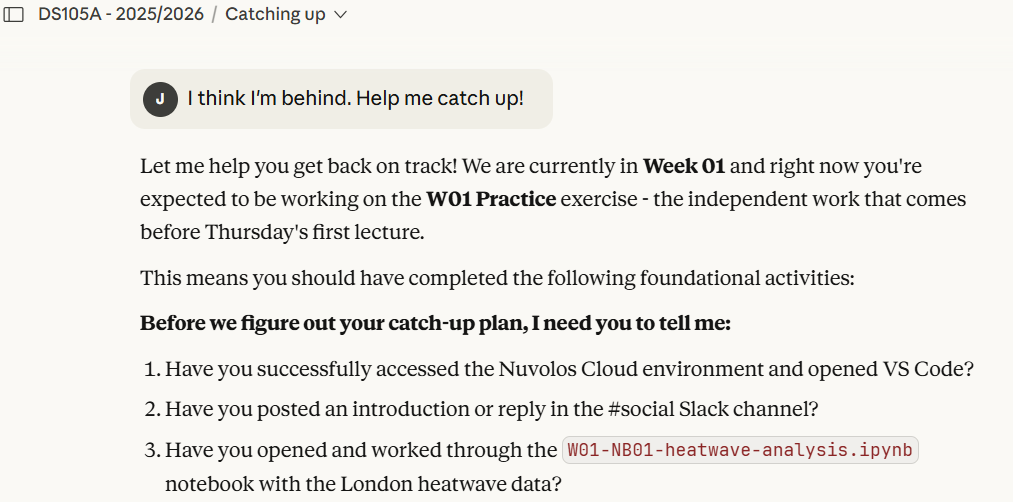
Tip: you can ask the DS105A Claude to give you a catch-up plan if you are behind.
🔖 Quick Links & Next Steps
📚 Resources
Slack workspace (link on Moodle)
![]() Nuvolos - First Time
Nuvolos - First Time- 📝 W01 Practice
- 3️⃣ Data Science Workflow
- 📔 Full Syllabus
💻 W01 Lab
Tomorrow’s lab session focuses on:
- Let’s take one step back in the data science workflow
- Working with daily temperature data
- Describe your thinking process
🗓️ Next Week
Week 02 focuses on:
- Python fundamentals (variables, data types, lists, dictionaries)
- Collecting real data in Python
📝 W02 Practice Exercise will be released tomorrow afternoon.
Any Burning Questions? 🔥
![]()
LSE DS105A (2025/26)